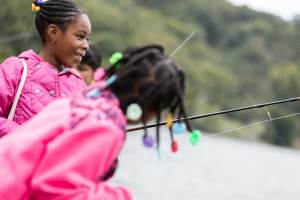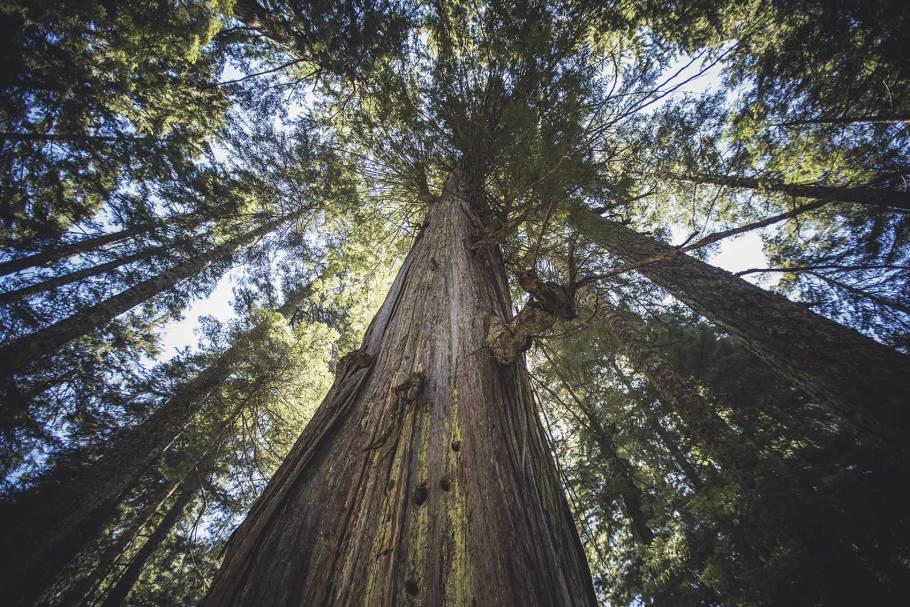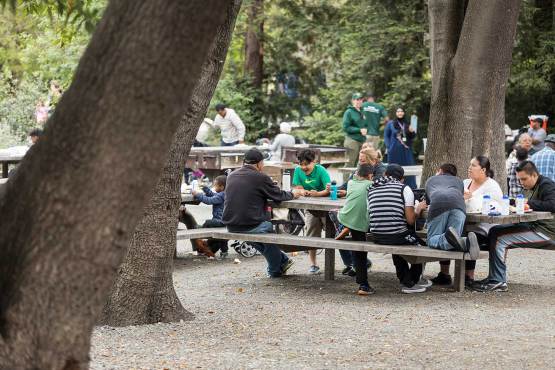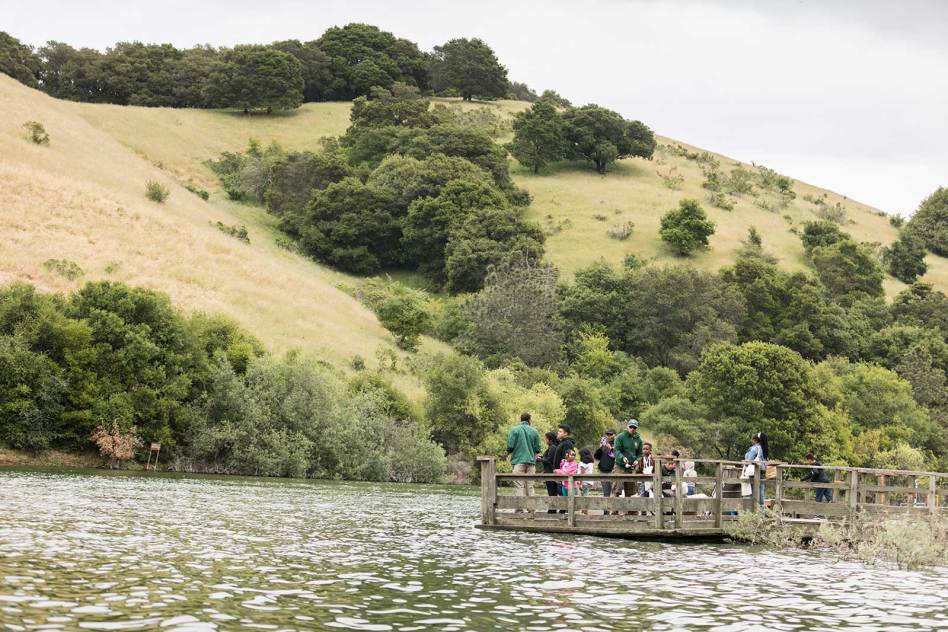Editor’s note on October 23, 2018: REI is an active investor in the growing body of research establishing the link between health and nature. Today, REI announced it’s investing $1 million to support the launch of a new initiative within the University of Washington’s EarthLab that will study the link between human health and time spent outdoors. Learn more about the new initiative, Nature for Health, and how it builds on existing bodies of work, like research examining the impact of hiking on veterans with post-traumatic stress disorder.
REI has already invested more than $1 million into efforts by UCSF Benioff Children’s Hospital’s Center for Nature and Health, University of Washington, Sierra Club, UC Berkeley’s Greater Good Science Center and the Oregon Public Health Institute to understand how time outside impacts anxiety levels, ability to focus, childhood development, happiness and other health factors.
In Oakland, California, rolling grass-covered slopes of the Oakland Hills give way to a grid of city streets that spill to the coast and the calm deep blue water of the bay. On one city block, there are shops and restaurants and trees. A weekly farmer’s market at Jack London Square draws a lively crowd. A few blocks away, a family of five asks for change to fill their gas tank and dilapidated tents are pitched under a freeway overpass.
Away from sirens and cracked concrete sidewalks, just 20 or 30 minutes outside of downtown, there are nine parks, preserves and recreational areas with lakes and trails, and more than 70 parks in the greater East Bay Regional Park District. Oak trees and chaparral are scattered on the hillside; eagles and hawks soar.
For some, it takes considerable effort, time and resources to reach the region’s natural spaces. Still, even with the economic and geographic divide, a group of low-income residents in Oakland is experiencing the outdoors with a prescription from their physician.
For more than three years, Dr. Nooshin Razani from UCSF Benioff Children’s Hospital Oakland has prescribed time outdoors to her pediatric patients and their families as a preventive medicine and is now collecting data as part of a randomized clinical trial. The goal, she says, is to examine how to operationalize a park prescription program in a low-income setting.


“From an equity perspective, sometimes there is an assumption that low-income people or people of color are not as interested in nature,” says Dr. Razani, “but that’s not what our findings show.”
Even with physician counseling and a prescription, Dr. Razani says she did not know if the patients would go, but they did—and they are noticing the health benefits.
“There is something about the trees and the oxygen here that is so calming,” says Veronica Tril, who was on a UCSF-hosted outing at Lake Chabot Regional Park in early May with her husband, Juan Antonio, and their 9-year-old son, Timothy. The family’s pediatrician referred the Trils to the clinical study and it was their second hosted park outing this year.
The topography of Oakland—a city of 425,000 people and the largest in the East Bay region of the San Francisco Bay area—not only illustrates the city’s geographic features, but also the income disparity and corresponding uneven access to nature. An estimated 20 percent of the population lives below the poverty level in Oakland, including 28 percent of those under the age of 18. At the same time, the San Francisco-Oakland-Hayward metro area has the highest median household income among the country’s most populous metro areas.
The area surrounding Lake Chabot, 15 miles southeast of downtown in the Oakland Hills, is dense with native live oak and eucalyptus trees, bright green and leafy with the spring bloom. Coastal redwood trees, which were planted in the 1800s, thrive in the picnic area. Visitors run and walk a trail circling the lake and anglers cast a line from the shore.
“Being in nature with other families—it gives us a little bit of light and hope to our reality.”
For the Tril family, the monthly park outings provide a reprieve from the challenges of everyday life; they lost their home in December, and Juan Antonio is recovering from a broken back. Their first outing was a naturalist-led walk at Crab Cove in Alameda where they learned about tides and the coastal ecosystem. They looked for crabs in tide pools and discovered worm poop. “Who knew? Worm poop!” Veronica said. “The kids loved that.”
Earlier that day, they ate a provided lunch with other families, went on a boat ride, took a fishing lesson and played volleyball on an outdoor court by the redwood trees. They say they would not have the resources for a day outdoors like this if it were not for the hosted outing compliments of the park prescription. Their worries seemingly became a little more manageable.
“We are really blessed—thankful to be here, even the meal itself, it’s nice to have a good sandwich,” Veronica said. “Being in nature with other families—it gives us a little bit of light and hope to our reality.”
The calming effect Veronica felt after a day outdoors in a natural environment is not uncommon. Plenty of research has proven that time in nature can benefit health and well-being, especially stress reduction and mood enhancement. Still, a lot of questions remain unanswered.
If nature is considered a preventive medicine, what is a healthy and sustainable dose? Is a physician’s recommendation enough or does the clinic need to host outings? Will insurance cover the cost?
Dr. Razani, who serves as director of the Center for Nature and Health at the children’s hospital, is not only asking these questions, but also researching possible answers.
Ever since Dr. Razani noticed that spending time outdoors with her own family was a way to cope with stress and loneliness, she decided to implement her personal experience in her practice.
“After I had children, I realized how isolating modern life was for me,” Dr. Razani said. “I felt the effect of the outdoors right away. Even simple things like taking my crying infant outside in the evenings to soothe colic.”
In 2010, she was trained as a Nature Champion, to be a pediatric health care leader in prescribing nature, by the National Environmental Education Fund. She then started writing park prescriptions and creating nature prescription programs in San Francisco. In 2014, she started collecting data for the study.
“Today is truly a [historic] day,” she said to a group of pediatric patients and their families in the clinic waiting room before the May outing to Lake Chabot Regional Park. Kids colored and played with Hula-Hoops while waiting to have their vital signs taken. “We are taking medicine to nature!”
This marked the first time clinic staff took vitals before a group park outing, which is part of the data collection that Dr. Razani hopes will eventually lead to evidence-based nature prescriptions for insurance purposes.
The study, which was published in the peer-reviewed PLOS ONE in February, showed reduced stress in the parents of pediatric patients at a clinic serving low-income families. The randomized clinical trial, which is the first of its kind, compared the effect of supported park outings versus independent park prescriptions with the goal of learning how to operationalize a park prescription program in a low-income setting.
During the three-month study, 78 parents of the patients, children ages 4 to 18, were randomized into two groups and prescribed supported or independent park prescriptions. Both groups received physician counseling about nature and were given maps of public transit and local parks, a journal and pedometer. The independent group visited parks on their own with a prescription to be outside in nature three times per week for one hour at a time with no further intervention. The supported group was invited on hosted weekly nature outings, like the visits to Crab Cove in Alameda and Lake Chabot Regional Park in the Oakland Hills, with provided transportation, lunch, and guided activities like nature walks, boating and fishing.
Dr. Razani and her staff measured the parents’ stress levels of both groups through salivary cortisol and through a series of survey questions—including the scientifically recognized 40-point Perceived Stress Scale—before the study began and at one and three months after enrolling in the program. Though stress did not differ significantly between the two groups, overall stress decreased by 1.71 points, or 4 percent.
“It’s a bold experiment—well-designed,” says Dr. John Spengler, Akira Yamaguchi Professor of Environmental Health and Human Habitation at Harvard University. “There will be other follow-up questions that will have to be answered, but it’s [a] start. It reaches a level of evidence and the evidence followed by monetization of outcomes becomes action for change.”
As more evidence is collected to show time in nature can serve as a viable public health intervention, the stronger the argument becomes for insurance reimbursement, or better yet, getting insurance companies interested in improving access to nature in low-income neighborhoods as a way to help keep populations healthy, Dr. Razani says.
The study was funded in part by East Bay Regional Parks District and the REI Foundation. For REI, the ultimate goal of supporting this research and similar studies is to have the country’s policymakers, decision-makers, and local and regional leaders appreciate that time outdoors is not just part of the American experience, but part of the quality of life and well-being, which everyone should have access to, says Marc Berejka, director of government and community affairs for REI.
Though the results did show an overall decrease in stress, more research is necessary. The sample was small, and there was no control group (one that was not prescribed time in nature) or prescribed time outdoors in an urban environment for comparison. Questions also remain as to how much nature and how often it should be experienced for the best results. Dr. Razani suspects shorter, more frequent trips into the outdoors, rather than the monthly-hosted group outing, might be the ultimate dosage for decreasing stress in her patients.
Most people get it—nature can benefit our health. Like coffee, wine and chocolate aficionados, outdoor enthusiasts are delighted each time another nature and well-being study is published.Our hobby is good for us!
“It’s not a hard concept for most to grasp—getting away from cities and pollution and noise and the calming effect of nature,” says Dr. Spengler. “Some of Olmsted’s early writing—and he’s the grandfather of landscape architecture—is what science is now trying to prove.”
Though time spent in nature is seemingly free, access across America is not equal. For those living in poverty, leisure time, even if it is considered a preventive medicine, can be cost prohibitive, and natural environments are not always readily available. Even if park prescriptions are implemented on a national scale, time spent outdoors represents only one potential solution for improving health outcomes for low-income individuals and families across the United States.
Many studies have shown the positive effects of nature on health and well-being, but research suggests that low-income neighborhoods across the U.S. have less green space, on average, than wealthier neighborhoods. Though access does not necessarily equate to use, a study in England suggests income-related health inequality might be decreased with greater exposure to nature.
Over the last decade, advances in big data and computer processing have made analyses of cities and parks more efficient and have indeed shown disparities, according to Dr. Kathleen Wolf, a research social scientist at the University of Washington.
“Now that we know this, you could ask two questions about those disparities: Why has that happened and what do we do about?” Dr. Wolf says. “That is going to be a policy and program approach.”

The waiting game continues as participants wonder whether they’ll catch anything. Photo by Ben Ditto
Increasing evidence shows brief exposure to trees and shrubs is beneficial, according to the Outside Our Doors report published by The Nature Conservancy. Children today spend more time indoors than ever before, but they do not necessarily need “wild nature” to reap the benefits of the natural world, the report says. In addition to park prescriptions, microdoses of nature in urban environments may also be an answer.
“What if we incorporate these health benefit goals into urban forestry, into stormwater management, into pocket parks, into common, everyday landscape?” Dr. Wolf asks. “With a little extra care we can create this beneficial health-inducing environment and offer people short-term, but frequent nature encounters in everyday life.”
Until then, physicians like Dr. Razani will keep talking to their patients about the importance of spending time outdoors.
While the U.S. is gaining momentum in this field of scientific research, other countries have been studying the effects of nature on health for much longer. Japan and Korea are especially strong in the field, Dr. Wolf says.
In 1982, Japan implemented forest bathing, or shinrin yoku, the practice of being outdoors in the presence of trees, as part of its national health program. The idea is simple: One spends relaxed time outdoors under the canopy of trees, meditating or walking slowly and observing nature without the distraction of electronic devices.
“Forests are an amazing resource. They give us everything we rely on in order to exist,” Dr. Qing Li, president of the Japanese Society of Forest Medicine, wrote in his new book Forest Bathing: How Trees Can Help You Find Health and Happiness (Viking 2018). “Until recently, however, there was little scientific evidence to support what we have always known innately about the healing power of the forest.”
Though walking anywhere is known to reduce stress, it is time in the forest that improves vigor and reduces fatigue, according to Dr. Li. Trees are known to clean the air and release oxygen, but Dr. Li’s research also shows that exposure to phytoncides, natural oils that are part of a tree’s defense system, has a range of health benefits from increasing anti-cancer proteins to decreasing stress hormones, increasing sleep, and decreasing anxiety, anger and fatigue. The bigger and the denser the forest, the better the results, he says, but his research also shows positive results from diffusing cypress oil indoors.

Forest bathing is slowly catching on in the U.S. along with park prescriptions. The Association of American Nature and Forest Therapy hosts workshops and retreats around North America and has a certified guide training program, and three books on the subject have been published in the U.S. this year. In Washington, D.C., Dr. Robert Zarr, the founder of the nonprofit Park Rx America and a pediatrician at Unity Health Care, started writing prescriptions to encourage patients to get outdoors to combat diabetes, obesity and mental health disorders. He also championed an online database listing D.C. parks by ZIP code.
In South Dakota, physicians started prescribing one free day in a park a few years ago in conjunction with a program run by South Dakota Game, Fish and Parks and the state’s Department of Health. Just across the bay from Oakland, in Marin City, California, doctors are prescribing park time and outdoor exercise for patients with hypertension, diabetes or obesity.
But what sets Dr. Razani’s park prescriptions apart is that her work is a part of a clinical trial with the aim of making park visits reimbursable by insurance. The next study will likely include a control group, she says.
After Dr. Razani and her staff took the patient’s vital signs, the group of 44 patients and their families boarded a yellow school bus bound for Lake Chabot Regional Park.
“Sometimes the hardest part is just getting here,” Dr. Razani yelled to the parents on the bus over the kids’ excitement. “I’m completely OK with chaos—they can run and play and be free.”
It was a gray day at the park, which is ideal for fishing. When the sun is shining, fish are hiding in the shadows, but the cloud cover meant they’d be swimming around in search of food.
The Tril family joined others to eat lunch at the large picnic tables before setting out on a boat tour of the lake. Some started casting lessons and halfway through the day the two groups switched activities.


“It smells like garlic,” 17-year-old Ajaniece said scrunching her nose. The fishing guide smooshed a ball of bright fluorescent bait onto her hook.
“Why does it have sparkles?” she asked.
“So it can be seen,” the guide explained. “Like, why do people put glitter on their face or in their hair? To be seen.”
She nodded and went back to practicing her underhand cast.
A pair of mallards swam around the dock, weaving through tall grasses. An East Bay Parks naturalist explained how to tell the difference between the male and female (the male mallards have bright green heads and yellow bills) and why the males are brightly colored (to attract mates).
Ajaniece has never caught a fish, but one time she hooked some algae, which felt like a fish on the line. When she was reeling it in, the line got stuck on a submerged log. The fishing pole bent over.
“The guides were egging me on,” she said. “They were telling me it was the biggest fish anyone had ever caught. It was a log—I caught a log.”
She laughed.
“All I caught was water,” her younger cousin added.

An early participant in the park prescription program, Ajaniece has gone to all but a few outings with her aunt and two younger cousins. They’ve learned about the native coastal redwoods in Oakland, made s’mores over a campfire, explored tide pools in Alameda’s Crab Cove, and learned about owls, ladybugs and trees on a number of naturalist walks in various parks. That day, she’d already taken a boat ride with Captain Glenn on the Chabot Queen. They’d motored around Live Oak Island and kept an eye on the sky in hopes of seeing a pair of resident nesting bald eagles and their eaglet. It was afternoon already and the outing was almost over for the day. The Tril family honed their casting technique in the picnic area while another group played volleyball on an outdoor court surrounded by redwood trees.
“Maybe today will be the day,” Ajaniece said casting the line, “that I catch my first fish.”
There were no bugs hatching and the noise of kids running around on the dock most likely scared the fish away. She seemed to know the chances of actually hooking a fish were slim.
Still, she had hope.